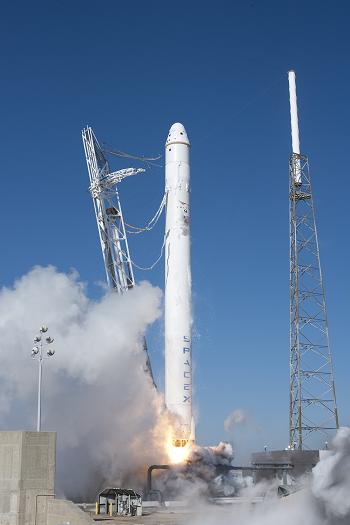 |
| Credits: NASA/Tony Gray and Kevin O’Connell |
… or to be more exact, the cheese re-entered the Earth’s atmosphere and performed a successful splashdown in the Pacific Ocean onboard SpaceX’s Dragon spacecraft on December 8, 2010. The same day, roughly three and a half hours earlier, the Dragon spacecraft was placed into low Earth orbit by a Falcon 9 launch vehicle, which lifted off from Cape Canaveral Air Force Station Space Launch Complex 40 on COTS Demo Flight 1.
On this flight, several key components of the Dragon spacecraft were tested: the Draco thrusters, which control the spacecraft throughout flight and reentry; the PICA-X heat shield, which is the SpaceX variant of NASA’s phenolic impregnated carbon ablator (PICA) heat shield; avionics; telemetry; and the drogue and main parachutes used for stabilization and landing.
The Dragon spacecraft is capable of fully autonomous rendezvous and docking, can carry over three metric tons in each of the pressurized and unpressurized sections, and it supports five to seven passengers in crew configuration. SpaceX’s primary goal for this demo flight was to collect as much data as possible.
Before the launch, Elon Musk, SpaceX CEO and CTO, made the following statement:
“When Dragon returns, whether on this mission or a future one, it will herald the dawn of an incredibly exciting new era in space travel. This will be the first new American human capable spacecraft to travel to orbit and back since the Space Shuttle took flight three decades ago. The success of the NASA COTS/CRS program shows that it is possible to return to the fast pace of progress that took place during the Apollo era, but using only a tiny fraction of the resources. If COTS/CRS continues to achieve the milestones that many considered impossible, thanks in large part to the skill of the program management team at NASA, it should be recognized as one of the most effective public-private partnerships in history.”










 Subscribe to blog posts using RSS
Subscribe to blog posts using RSS










